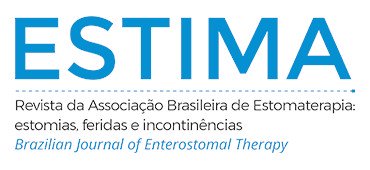USE OF THE HUMAN PLACENTA IN THE HEALING OF FOOT ULCERS IN PEOPLE WITH DIABETES: INTEGRATIVE REVIEW
Abstract
Objective: To identify in the literature the contributions of the use of the human placenta in the healing of foot ulcers in people with diabetes. Method: An integrative review study carried out by searching articles in
Literatura Latino-Americana e do Caribe em Ciências da Saúde (LILACS), Scientific Electronic Library Online (SciELO), Cumulative Index to Nursing and Allied Health Literature (CINAHL), Cochrane Library, National Library
of Medicine (PubMed), Web of Science and Scopus, using the search strategies: Placenta AND “Diabetic foot” and Placenta AND “Diabetic Foot”. Results: The initial search resulted in 148 articles. After applying the inclusion and exclusion criteria, a final sample of 12 articles was obtained. It was observed that the placenta has the potential to promote the improvement of granulation tissue and peripheral circulation, greater epithelialization, and reduction in the wound area, with the majority use of cryopreserved placental and amniotic membrane allograft. Conclusion: The human placenta is a nutrient-rich biological material that has the potential to contribute to the tissue repair of foot ulcers in people with diabetes in a shorter period of time.
Downloads
Metrics
References
Hitscherich PG, Chnari E, Deckwa J, Long M, Khalpey Z. Human placental allograft membranes: promising role in cardiac surgery and repair. Front Cardiovasc Med 2022;9:809960. https://doi.org/10.3389/fcvm.2022.809960
Klama-Baryla A, Rojczyk E, Kitala D, Labuś W, Smętek W, Wilemska-Kucharzewska K, et al. Preparation of placental tissue transplants and their application in skin wound healing and chosen skin bullous diseases - Stevens-Johnson syndrome and toxic epidermal necrolysis treatment. Int Wound J 2020;17(2):491-507. https://doi.org/10.1111/iwj.13305
Meamar R, Ghasemi-Mobarakeh L, Norouzi MR, Siavash M, Hamblin MR, Fesharaki M. Improved wound healing of diabetic foot ulcers using human placenta-derived mesenchymal stem cells in gelatin electrospun nanofibrous scaffolds plus a platelet-rich plasma gel: A randomized clinical trial. Int Immunopharmacol 2021;101(Pt B):108282. https://doi.org/10.1016/j.intimp.2021.108282
Zubair M. Prevalence and interrelationships of foot ulcer, risk-factors and antibiotic resistance in foot ulcers in diabetic populations: A systematic review and meta-analysis. World J Diabetes 2020;11(3):78-89. https://doi.org/10.4239/wjd.v11.i3.78
Andrade LL, Carvalho GCP, Valentim FAAA, Siqueira WA, Melo FMAB, Costa MML. Characteristics and treatment of diabetic foot ulcers in an ambulatory care. Rev Fun Care Online 2019;11(1):124-8. https://doi.org/10.9789/2175-5361.2019.v11i1.124-128
Ananian CE, Davis RD, Johnson EL, Regulski MJ, Reyzelman AM, Saunders MC, et al. Wound closure outcomes suggest clinical equivalency between lyopreserved and cryopreserved placental membranes containing viable cells. Adv Wound Care 2019;8(11):546-54. https://doi.org/10.1089/wound.2019.1028
Glat P, Orgill DP, Galiano R, Armstrong D, Serena T, DiDomenico LA, et al. Placental membrane provides improved healing efficacy and lower cost versus a tissue-engineered human skin in the treatment of diabetic foot ulcerations. Plast Reconstr Surg Glob Open 2019;7(8):e2371. https://doi.org/10.1097/GOX.0000000000002371
Oesman I, Dhamar Hutami W. Gamma-treated placental amniotic membrane allograft as the adjuvant treatment of unresponsive diabetic ulcer of the foot. Int J Surg Case Rep 2020;66:313-8. https://doi.org/10.1016/j.ijscr.2019.12.033
Brasil. Resolução RDC no 222, de 28 de março de 2018. Regulamenta as Boas Práticas de Gerenciamento dos Resíduos de Serviços de Saúde e dá outras providências [Internet]. Brasil; 2018 [acessado em 22 jan. 2022]. Available at:https://www.in.gov.br/materia//asset_publisher/Kujrw0TZC2Mb/content/id/8436198/do1-2018-03-29-resolucao-rdc-n-222-de-28-de-marco-de-2018-8436194
Mendes KS, Silveira RCCP, Galvão CM. Uso de gerenciador de referências bibliográficas na seleção dos estudos primários em revisão integrativa. Texto Contexto - Enferm 2019;28:e20170204. https://doi.org/10.1590/1980-265X-TCE-2017-0204
Tostes MFP, Galvão CM. Implementation process of the Surgical Safety Checklist: integrative review. Rev Latino-Am Enfermagem 2019;27:e3104. https://doi.org/10.1590/1518-8345.2921.3104
Ursi ES, Galvão CM. Prevenção de lesões de pele no perioperatório: revisão integrativa da literatura. Rev Latino-Am Enfermagem 2006;14(1):124-31. https://doi.org/10.1590/S0104-11692006000100017
Zelen CM, Serena TE, Denoziere G, Fetterolf DE. A prospective randomised comparative parallel study of amniotic membrane wound graft in the management of diabetic foot ulcers. Int Wound J 2013;10(5):502-7. https://doi.org/10.1111/iwj.12097
Frykberg RG, Gibbons GW, Walters JL, Wukich DK, Milstein FC. A prospective, multicentre, open-label, single-arm clinical trial for treatment of chronic complex diabetic foot wounds with exposed tendon and/or bone: positive clinical outcomes of viable cryopreserved human placental membrane. Int Wound J 2017;14(3):569-77. https://doi.org/10.1111/iwj.12649
Ananian CE, Dhillon YS, Van Gils CC, Lindsey DC, Otto RJ, Dove CR, et al. A multicenter, randomized, single-blind trial comparing the efficacy of viable cryopreserved placental membrane to human fibroblast-derived dermal substitute for the treatment of chronic diabetic foot ulcers. Wound Repair Regen 2018;26(3):274-83. https://doi.org/10.1111/wrr.12645
Raspovic KM, Wukich DK, Naiman DQ, Lavery LA, Kirsner RS, Kim PJ, et al. Effectiveness of viable cryopreserved placental membranes for management of diabetic foot ulcers in a real world setting. Wound Repair Regen 2018;26(2):213-20. https://doi.org/10.1111/wrr.12635
Lavery LA, Fulmer J, Shebetka KA, Regulski M, Vayser D, Fried D, et al. The efficacy and safety of Grafix(®) for the treatment of chronic diabetic foot ulcers: results of a multi-centre, controlled, randomised, blinded, clinical trial. Int Wound J 2014;11(5):554- 60. https://doi.org/10.1111/iwj.12329
Sabolinski ML, Capotorto JV. Comparative effectiveness of a human fibroblast-derived dermal substitute and a viable cryopreserved placental membrane for the treatment of diabetic foot ulcers. J Comp Eff Res 2019;8(14):1229-38. https://doi.org/10.2217/cer-2019-0001
Chisari LM, Antonino G, Arcidiacono G, Chisari LM. Human amniotic membrane in diabetic foot healing processes: a retrospective study. Acta Med Mediterr 2021;37:1399. https://doi.org/10.19193/0393-6384_2021_3_223
Werber B, Martin E. A prospective study of 20 foot and ankle wounds treated with cryopreserved amniotic membrane and fluid allograft. J Foot Ankle Surg 2013;52(5):615-21. https://doi.org/10.1053/j.jfas.2013.03.024
Wu SC, Pollak R, Frykberg RG, Zhou W, Karnoub M, Jankovic V, et al. Safety and efficacy of intramuscular human placenta-derived mesenchymal stromal-like cells (cenplacel [PDA-002]) in patients who have a diabetic foot ulcer with peripheral arterial disease. Int Wound J 2017;14(5):823-9. https://doi.org/10.1111/iwj.12715
Pacaccio DJ, Cazzell SM, Halperin GJ, Kasper MA, Neutel JM, O’Carroll BD, et al. Human placental membrane as a wound cover for chronic diabetic foot ulcers: a prospective, postmarket, CLOSURE study. J Wound Care 2018;27(Supl. 7):S28-S37. https://doi.org/10.12968/jowc.2018.27.Sup7.S28
Swoboda L. A retrospective analysis of clinical use and outcomes using viable placental membrane allografts in chronic wounds. Wounds 2021;33(12):329-33. https://pubmed.ncbi.nlm.nih.gov/34882575/
Downloads
Published
How to Cite
Issue
Section
License
Copyright (c) 2022 Francisca Sousa Lima, Maria Girlane Sousa Albuquerque Brandão, Dara Cesario Oliveira, Aline de Oliveira Ramalho, Anne Fayma Lopes Chaves, Thiago Moura de Araújo, Vivian Saraiva Veras

This work is licensed under a Creative Commons Attribution 4.0 International License.

























